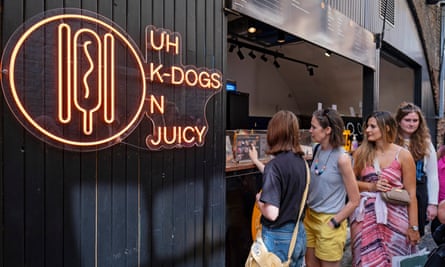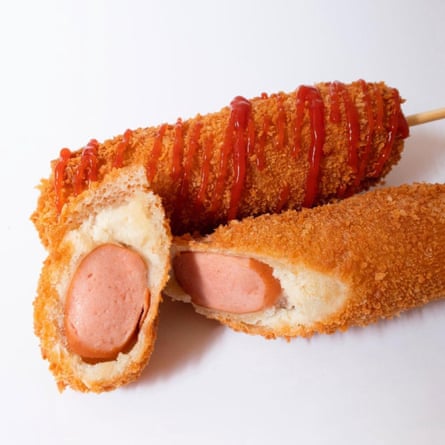‘If you’d told me two years back, when I first started selling Korean hotdogs, that I’d be interviewed by the Guardian, I’d be like, ‘No way,’” exclaims Mari Riaz, founder and owner of Uh K-dogs ’n’ Juicy in Camden market, London. And yet here we are, in the calm before the lunchtime rush, discussing the street food trend she helped kickstart from her home kitchen in 2020, and which is now sweeping the UK.
At this point, I’ve yet to have one. I’ve seen them at street food markets and on social media, and I’ve even heard the shattering crunch of the crisp batter as devourers bite in – yet the texture and flavour of the Korean hotdog remains a mystery to me. I can imagine, though, or at least I think I can, from what I know of their contents: stringy mozzarella, a hotdog sausage of some variety, coated in a dough that may or may not be embellished with cereal or noodles, layered on to a stick, deep-fried and finished with stripes of ketchup, mayonnaise, mustard or sweet chilli sauce.
The similarities to the American corn dog are plain, and indeed Korean hotdogs are a direct descendant: created in 1980s Korea as an easy street food that could make a small, cheap bit of meat go further. “Hotdogs, alongside other tinned and processed meats, were first introduced to the peninsula during the Korean war as part of army rations,” says Judy Joo, an American-Korean chef, restaurateur and cookbook author based in London. “It is thought that someone saw the quintessential American fairground food, corn dogs, and adapted it.”
Cornmeal was replaced with wheat flour and as demand and competition grew, so did the hotdogs. “The pieces became bigger and the fillings changed, incorporating cheese and fishcakes,” says Joo. More noticeably, street food vendors got increasingly creative with the coatings, covering them with everything from bits of french fries to dried ramen noodles, potato – even Rice Krispies or Cheetos.

In Koreatown, Los Angeles, where Joo grew up, Korean hotdogs were an after-school treat. “I remember snacking on them greedily, pulling the cheesy insides out and wrapping the gooey cheese around my finger.” The “cheese pull” of the K-dog is an extraordinary thing: a long string of melted cheese that stretches endlessly with each bite, to the point where you start contemplating scissors.
“I remember the first day we opened in Camden market, and people didn’t have a clue what we were selling; then a customer bought one out of curiosity, and it was the massive cheese pull from that first bite that then attracted loads of people,” recalls Riaz.
In the UK, Korean hotdogs are still relatively new on the scene, brought over via the US off the back of K-drama, K-pop, K-beauty and so on. “I think the popularity of Korean culture, the hallyu wave, is fuelling the appetite for Korean food,” says Joo – just as in South Korea, young people’s fascination with American culture drove the demand for Korean hotdogs in the first place.
“The older generation remain health-conscious, and drink green tea and eat fish and kimchi and so on – but palates are changing. The younger generations have been tending more toward a fast-food culture over recent years,” Riaz observes.
What’s interesting about the Korean hotdogs is the many stages of their evolution: from the US, to Korea, back to the US with American-Koreans, then from there to the rest of the world. As Korean chef Linda Lee – owner of On the Bab and Koba in London – puts it: “The origins are American, yes, but as a street food dish they are so entwined with Korean culture that the line is blurred.”
Lee doesn’t serve K-dogs, but she feels their success is indicative of the growing interest in all kinds of Korean cuisine – and that can only be positive. “I am certain everyone will find something new to try. At On the Bab we have a stew called budae jjigae which contains sausages, ham, noodles and a slice of burger cheese, so that’s a different type of Korean dish with American flavours.”
When setting up in the UK, Riaz was conscious that the traditional K-dog, which incorporates sugar into the batter, might be too sweet for the British palate. In addition, many of her customers were Muslim, so the pork in the sausage meat was not suitable. As a result, she adapted the dish further, replacing the pork sausages with turkey or vegetarian ones, and removing the sugar from the batter.

“A lot of people love the traditional version, but even for me, it’s like a doughnut filled with sausage and cheese,” she says. “The vast majority of our customers prefer our version because it’s less sweet.”
“Throughout history you see people taking inspiration from other cuisines and making it their own. It’s evolution,” says food influencer and financier Kar-Shing Tong, better known by his social media handle KS Ate Here. For 14 years Tong has been sharing and snapping street food trends in London. He’s not surprised by the Korean hotdog’s success, nor that it has made its way across the Atlantic.
“Korea has had a big American culture for a while. Then food trends from Asia usually come here via the States. It’s the natural progression after they’re popularised there: all things American see London as the new playground,” he continues. From London, it is but a hop, skip and a jump to the rest of the UK.
Purveyors of K-dogs have been popping up on streets and in street food markets in Manchester, Glasgow, Newcastle and more – and no wonder, says Tong: “It’s sausage and mozzarella in batter. Who’s not going to eat that?”
Where cultural differences might limit the appeal of some culinary imports from Asia, he continues, “with the Korean hotdog there is nothing that can go wrong”. It is the perfect street food – and the perfect festival food, says Riaz, being quick, filling and, crucially, drink-friendly: “I always say the definitive festival food is the one you can hold in one hand while holding a pint in the other.”
K-dogs are clearly catnip for social media: “There’s the massive cheese pull, the colourful sauces on top, and the crunchy sound makes them very popular for mukbang [videos of people eating food, which amass huge followings on TikTok and Instagram].” To Riaz’s mind this is the main reason K-dogs have really blown up of late, despite having been around for about three decades.
“I am a huge fan of ASMR [autonomous sensory meridian response – in other words, a pleasing tingling sensation], which you experience when you can very clearly hear the sounds of people eating food on mukbang. K-dogs became famous through those videos. That is how western culture was introduced to them,” she says, and it’s what gave her the confidence to introduce Uh K-dogs ’n’ Juicy to Camden. But they weren’t designed for social media, says Tong: “They’re not freakshakes [milkshakes loaded with whipped cream, cakes, cookies, sweets and sauces to create a structurally improbable and impossibly sickly sweet feast]. They’re not just about the ‘wow’ visual factor. They’re a completely viable, edible thing: filling and borderline excessive, but probably no worse for you than a battered sausage from your local fish and chip shop.”
They are also – and here, my snobbery initially got the better of me – just good fun. Sure, they are sugar, fat and processed meat – all of the bad things – deep-fried, but no one is suggesting you demolish a K-dog a day. When I pick one up from the growing London chain Bunsik for lunch, I am pleasantly surprised.
The cheese is stringy and creamy, the meat discernibly meat, the batter as crunchy as I’d been led to believe. But it was the fun I was most struck by: the childish joy of wandering through Soho with my lunch on a lollipop stick, winding cheese around my fingers, a smile and sweet chilli sauce around my mouth.

Comments (…)
Sign in or create your Guardian account to join the discussion